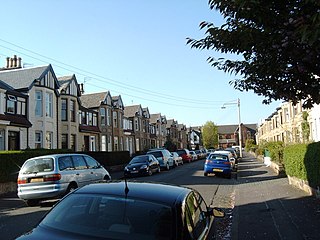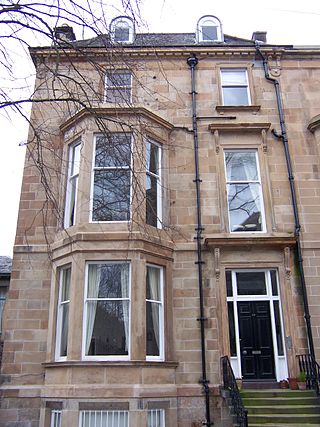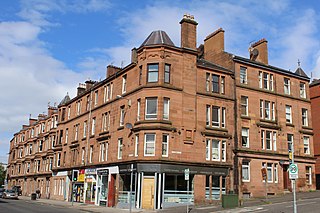
Partick is an area of Glasgow on the north bank of the River Clyde, just across from Govan. To the west lies Whiteinch, to the east Yorkhill and Kelvingrove Park, and to the north Broomhill, Hyndland, Dowanhill, Hillhead, areas which form part of the West End of Glasgow. Partick was a Police burgh from 1852 until 1912 when it was incorporated into the city. Partick is the area of the city most connected with the Highlands, and several Gaelic agencies, such as the Gaelic Books Council are located in the area. Some ATMs in the area display Gaelic.

Jordanhill is an affluent area of the West End of the city of Glasgow, Scotland. The area consists largely of terraced housing dating from the early to mid 20th century, with some detached and semi-detached homes and some modern apartments.

The North Clyde Line is a suburban railway in West Central Scotland. The route is operated by ScotRail Trains. As a result of the incorporation of the Airdrie–Bathgate rail link and the Edinburgh–Bathgate line, this route has become the fourth rail link between Glasgow and Edinburgh.

Kelvindale is a district in the West End of the city of Glasgow, Scotland. Kelvindale shares the G12 postcode with the neighbouring residential districts of Kelvinside, Hillhead, Hyndland, Dowanhill, as well as Gartnavel General Hospital, Glasgow Clyde College (Anniesland) and the University of Glasgow, and is also close to the Anniesland and Wyndford areas of the city. The area is characterised by traditional interwar housing, formed of tenements and semi-detached houses.

Hyndland is a residential area in the West End of the city of Glasgow, Scotland.

Gillespie, Kidd & Coia was a Scottish architectural firm famous for their application of modernism in churches and universities, as well as at St Peter's Seminary in Cardross. Though founded in 1927, they are best known for their work in the post-war period. The firm was wound up in 1987.

Broomhill is a district in the West End of the city of Glasgow, Scotland. North of the River Clyde, it is bounded by the districts of Thornwood and Partick to the south, Hyndland to the east, and Jordanhill, Scotstoun and Victoria Park to the west.

Kelvinside is a district in the Scottish city of Glasgow. It is situated north of the River Clyde and is bounded by Broomhill, Dowanhill and Hyndland to the south with Kelvindale and the River Kelvin to the north. It is an affluent area of Glasgow, with large Victorian villas and terraces.

Hyndland railway station serves Hyndland in Glasgow, Scotland. The station is 3+1⁄4 miles (5.2 km) west of Glasgow Central and 2+3⁄4 miles (4.4 km) west of Glasgow Queen Street on the Argyle and North Clyde Lines. It is managed by ScotRail.
The Stobcross Railway was a railway line in Glasgow, Scotland, built by the North British Railway to connect from Maryhill to the new dock being built at Stobcross; the dock became the Queen's Dock, opened in 1877. The line was opened first, in 1874, and gave the North British company access to the north bank of the River Clyde; there was a goods depot at Partick.

Hyndland Secondary School is a non-denominational state comprehensive school in the Hyndland area of Glasgow, Scotland.

Partickhill railway station was a railway station serving the Partick area of Glasgow. The station was opened by the North British Railway Company in 1874 on the north side of Dumbarton Road. At some periods during its existence it was described as Partick for Govan in some timetables.

Thornwood is a largely residential area of Glasgow, Scotland, lying north of the River Clyde. Part of the city's West End, it is situated almost on the river between Partick to the east and south and Broomhill to the north and west; the neighbourhoods of Whiteinch, Glasgow Harbour and Hyndland are also fairly close.

Alexander Buchanan Campbell was a Scottish architect. He was born in Findochty, Scotland.

St. Peter's Seminary is a former Roman Catholic seminary near Cardross, Argyll and Bute, Scotland. Designed by the firm of Gillespie, Kidd & Coia, it has been described by the international architecture conservation organisation DOCOMOMO as a modern "building of world significance". It is one of only 42 post-war buildings in Scotland to be listed at Category A, the highest level of protection for a building of "special architectural or historic interest". It has been abandoned since 1987, and is currently in a ruinous state. In July 2020, the site was gifted to the Kilmahew Education Trust Ltd who plan to reinstate the educational elements of the Seminary Complex after a process of conservation and restoration. The wider Kilmahew Estate is to be brought back to its former glory with new landscaping and features but is currently closed to the public due to safety concerns.

Bearsden Academy is a non-denominational, state secondary school in Bearsden, East Dunbartonshire, Scotland.

Isi Israel Metzstein OBE was a German-born architect who worked at Gillespie, Kidd & Coia and taught at the Glasgow School of Art. He became known for his postwar architectural designs working in the European modernist style of Le Corbusier and the American Frank Lloyd Wright.

William Leiper FRIBA RSA (1839–1916) was a Scottish architect known particularly for his domestic architecture in and around the town of Helensburgh. In addition, he produced a small amount of fine ecclesiastical and commercial architecture in Glasgow and the Scottish Lowlands. He was also an accomplished watercolour artist, and from the late 1870s spent much spare time painting in oils and watercolours.

Partick East/Kelvindale is one of the 23 wards of Glasgow City Council; used since the 2017 local election, it is one of two created from the Local Government Boundary Commission for Scotland's 5th Review. The ward returns four council members.
Notre Dame College of Education was a Catholic teacher training college in Glasgow, Scotland. It was opened in 1895 as a women's college by the Sisters of Notre Dame de Namur, admitting male students from 1967 and merging with Craiglockhart College in 1981 to become St Andrew's College of Education. St Andrew's College become the Faculty of Education of the University of Glasgow in 1999.


















